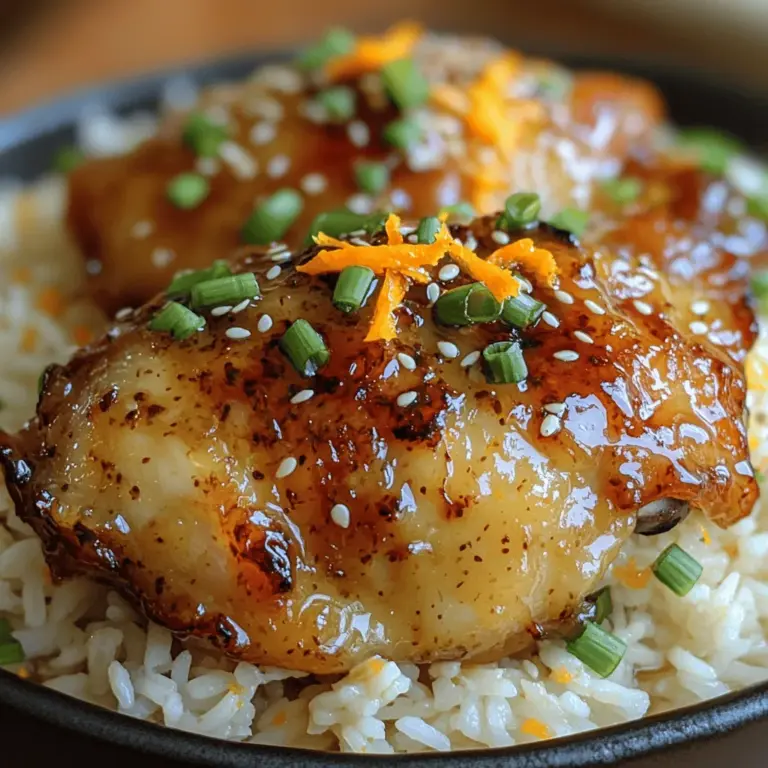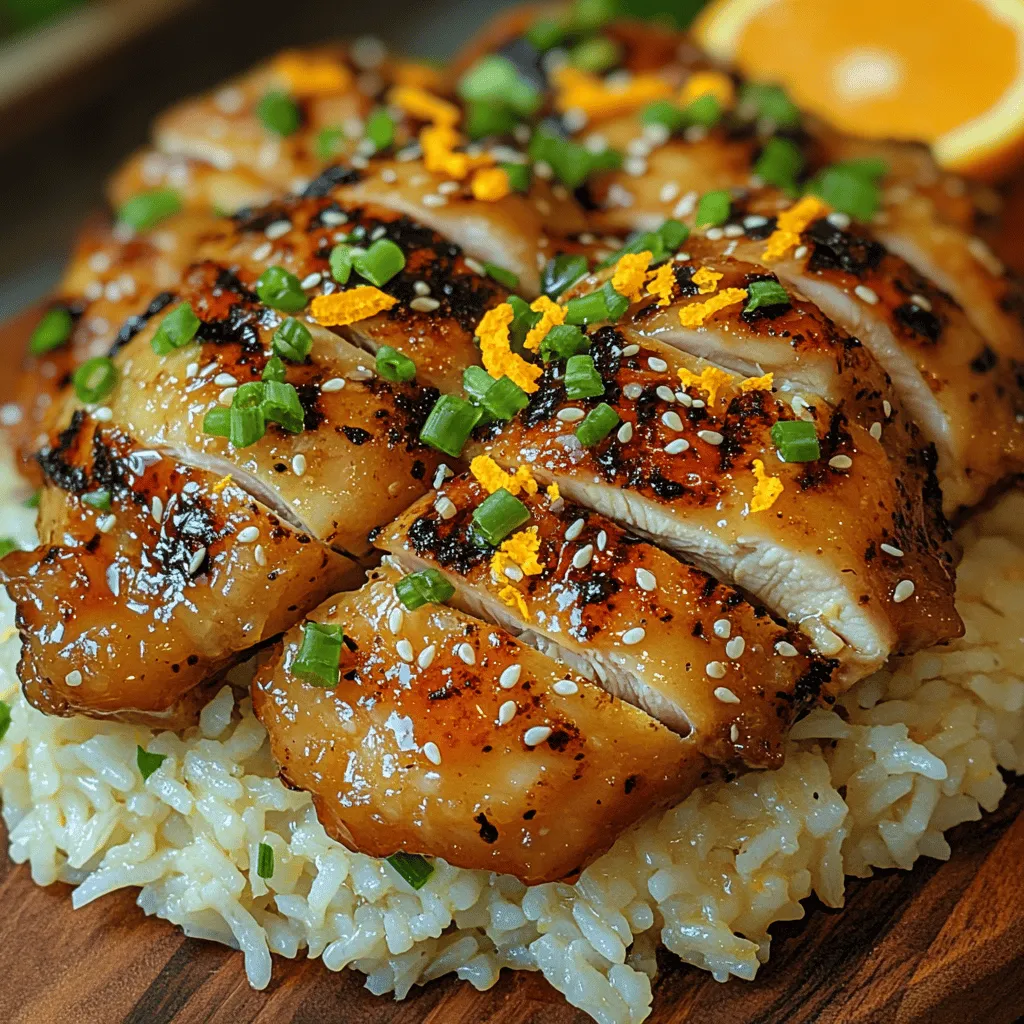Introduction
If you’re looking for a dish that perfectly marries the zestiness of fresh orange with the warm, spicy notes of ginger, look no further than Ginger Orange Glazed Chicken. This tantalizing recipe not only delivers a delightful flavor experience but also serves as a healthier alternative to many traditional chicken dishes. By choosing skinless chicken thighs, you enjoy a succulent meal without the excess fat, allowing the vibrant glaze to truly shine.
The combination of ginger and orange creates a unique flavor profile that is both refreshing and comforting, making it an exceptional choice for both casual weeknight dinners and more refined gatherings. This dish is highly adaptable, pairing beautifully with sides like fluffy jasmine rice or hearty quinoa, catering to various dietary preferences. Whether you’re entertaining guests or just looking to elevate your weekday meals, this Ginger Orange Glazed Chicken is sure to impress.
Understanding the Ingredients
Every great dish starts with great ingredients, and this recipe is no exception. Understanding the significance of each component not only enhances the cooking experience but also enriches the flavor of the final product.
Boneless Chicken Thighs
For this recipe, we use boneless skinless chicken thighs, which are an excellent choice for several reasons. First, chicken thighs are inherently more tender and juicier than their breast counterparts, making them ideal for absorbing marinades and flavorful glazes. By opting for skinless thighs, you reduce the overall fat content without sacrificing moisture or taste. This choice strikes a perfect balance, allowing the bright flavors of the marinade to penetrate the meat while keeping the dish light and healthy.
Fresh Orange Juice and Zest
When it comes to achieving a vibrant flavor in your dish, using fresh ingredients is paramount. For this recipe, the juice and zest of fresh oranges are key players. The zest, which is the outer peel of the orange, contains essential oils that impart a concentrated orange flavor, elevating the dish beyond just using juice alone. Fresh orange juice offers a natural sweetness and acidity that balances the richness of the chicken, creating a harmonious glaze that coats the meat beautifully. A good tip is to always opt for fresh-squeezed juice to ensure your dish is bursting with flavor.
Ginger
Fresh ginger is another star ingredient in this recipe. Known for its warm, spicy flavor, ginger not only enhances the taste but also brings a host of health benefits. It is recognized for its anti-inflammatory properties and digestive benefits, making it a popular choice in many cuisines, particularly in Asian cooking. When using ginger in this dish, you’ll want to ensure it is freshly grated or minced to release its oils and maximize its flavor impact. The spiciness of ginger complements the sweetness of the orange, creating a well-rounded taste experience.
Soy Sauce
Soy sauce is a fundamental ingredient in many marinades, and for this dish, it plays a crucial role in developing depth of flavor. When selecting soy sauce, consider using a low-sodium variety. This not only helps to keep the dish healthier but also allows the other flavors—such as the sweet orange juice and spicy ginger—to shine through without being overwhelmed by saltiness. The umami notes from the soy sauce enhance the overall taste, making the glaze rich and complex.
Honey vs. Maple Syrup
Sweeteners are essential for balancing flavors in savory dishes. In this recipe, you have the option to use either honey or maple syrup. Both options bring their unique characteristics to the glaze. Honey tends to offer a floral sweetness that pairs beautifully with the citrus, while maple syrup adds a subtle earthiness. If you are looking for a vegan alternative, maple syrup is the way to go. Regardless of your choice, these natural sweeteners are far superior to refined sugars, providing more flavor and nutrients.
Garlic and Vinegar
Garlic is a staple in many culinary traditions, and it adds a pungent, aromatic quality to the marinade. In this recipe, minced garlic enhances the overall flavor profile, balancing the sweetness of the orange and honey with a savory edge. Additionally, a splash of vinegar—whether apple cider or rice vinegar—adds acidity that brightens the dish and cuts through the richness of the chicken. The interplay of these ingredients creates a glaze that is dynamic and layered, ensuring every bite is packed with flavor.
Marinating the Chicken
One of the most crucial steps in preparing Ginger Orange Glazed Chicken is marinating the chicken. Marination serves to infuse the meat with flavor and helps to tenderize it, resulting in a juicier and more flavorful dish.
The Importance of Marinating
Marinating chicken is not just about adding flavor; it’s also about transforming the texture of the meat. The acids in the marinade, from ingredients like orange juice and vinegar, help to break down the proteins in the chicken, making it more tender. Additionally, marination allows the spices and flavors to penetrate deeply into the meat, ensuring that each bite is bursting with taste.
The Marination Process
To marinate the chicken, start by preparing the marinade in a bowl. Combine fresh orange juice, orange zest, grated ginger, soy sauce, your choice of sweetener (honey or maple syrup), minced garlic, and a splash of vinegar. Whisk these ingredients together until well blended.
Next, place the boneless skinless chicken thighs in a resealable plastic bag or a shallow dish, and pour the marinade over them. Ensure that the chicken is evenly coated with the marinade. Seal the bag or cover the dish with plastic wrap, and refrigerate.
Ideal Marination Time
For optimal flavor absorption, marinate the chicken for at least 30 minutes; however, if time allows, aim for 1-2 hours. For even deeper flavor, you can marinate the chicken overnight. Just be mindful not to exceed 24 hours, as the acids in the marinade can start to break down the meat too much, resulting in a mushy texture.
Maximizing Flavor Absorption
To maximize flavor absorption, consider giving the chicken a gentle massage while in the marinade. This helps to ensure that the marinade gets into every crevice of the meat. Additionally, bringing the chicken to room temperature before cooking can help it cook evenly and allows the flavors to meld better.
Cooking Methods Explored
Once your chicken has marinated, it’s time to cook it. There are several methods you can choose from, each offering its own unique benefits and flavor profiles.
Grilling
Grilling is one of the best methods for cooking Ginger Orange Glazed Chicken, as it imparts a smoky flavor that complements the sweetness of the glaze beautifully. The high heat of the grill also helps to caramelize the sugars in the glaze, creating a delicious crust on the outside while keeping the inside moist and tender.
When grilling, preheat your grill to medium-high heat. Remove the chicken from the marinade (reserving the marinade for later use) and place it on the grill. Grill each side for about 6-7 minutes, depending on the thickness of the thighs, until they reach an internal temperature of 165°F (75°C). To enhance the glaze, brush the chicken with the reserved marinade during the last few minutes of grilling.
In addition to grilling, you can also explore other cooking methods such as baking or pan-searing, each offering a different flavor and texture profile. Each method has its advantages, and depending on your preference and available equipment, you can choose the one that best suits your needs.
By utilizing these cooking techniques and understanding the importance of each ingredient, you’ll be well on your way to creating a remarkable Ginger Orange Glazed Chicken that will have your taste buds dancing. Stay tuned for the next part of this article, where we will delve deeper into the cooking methods and provide tips for serving this delightful dish.
Achieving the Perfect Sear: Stovetop Tips for Ginger Orange Glazed Chicken
To achieve a beautifully seared Ginger Orange Glazed Chicken, start by ensuring your skillet is preheated over medium-high heat. This step is essential for developing a golden crust that locks in the juicy tenderness of the chicken. Here are some tips to get that perfect sear:
1. Choose the Right Skillet: Use a heavy-bottomed skillet or cast iron pan, as these retain heat well and provide even cooking. Non-stick pans can also work but may not achieve the same level of browning.
2. Dry the Chicken: Pat the chicken thighs dry with paper towels before seasoning. Removing excess moisture allows for better browning.
3. Use the Right Oil: Opt for high smoke point oils like canola, avocado, or grapeseed oil. Avoid using butter at this stage, as it can burn before the chicken is properly seared.
4. Don’t Crowd the Pan: If you’re cooking multiple pieces, make sure there’s enough space in the skillet. Overcrowding can lead to steaming rather than searing.
5. Monitor Cooking Time: Chicken thighs typically require about 6-8 minutes per side, depending on thickness. Use a meat thermometer to check for an internal temperature of 165°F to ensure they’re fully cooked.
6. Resting the Chicken: After searing, allow the chicken to rest for a few minutes before glazing. This helps the juices redistribute, ensuring each bite is juicy and flavorful.
Creating the Ginger Orange Glaze
The glaze is the star of the show in this recipe, adding a burst of flavor that complements the chicken beautifully. Here’s how to prepare it step by step:
1. Gather Ingredients: For the glaze, you will need:
– 1 cup fresh orange juice (from about 3-4 oranges)
– Zest of 1 orange
– 1 tablespoon freshly grated ginger
– 2 tablespoons honey or maple syrup
– 2 tablespoons soy sauce (or a gluten-free alternative)
– 1 tablespoon cornstarch mixed with 2 tablespoons water (to thicken)
2. Combine Ingredients: In a saucepan, combine the orange juice, zest, ginger, honey or maple syrup, and soy sauce. Stir well to mix all the ingredients thoroughly.
3. Bring to a Boil: Heat the mixture over medium heat until it begins to boil. This step is crucial; boiling the marinade not only kills any bacteria from the raw chicken but also intensifies the flavors.
4. Thicken the Glaze: Reduce the heat to low and add the cornstarch mixture. Stir continuously until the glaze thickens and becomes glossy, which should take about 2-3 minutes. If the glaze becomes too thick, you can add a bit more orange juice or water to reach your desired consistency.
5. Final Touches: Once thickened, remove the glaze from heat and allow it to cool slightly before drizzling it over the chicken.
The glaze serves to elevate both the flavor and presentation of the dish. Its vibrant color and sheen not only make the chicken visually appealing but also create a delightful contrast against the savory notes of the chicken.
Serving Suggestions
When it comes to serving Ginger Orange Glazed Chicken, the right accompaniments can enhance the meal experience. Here are some ideas:
1. Best Side Dishes: Pair the chicken with fluffy jasmine rice or nutty quinoa. Both grains absorb the glaze beautifully, allowing each bite to be a perfect balance of flavors. Consider a side of steamed vegetables—such as broccoli or snap peas— for added nutrients and color on the plate.
2. Garnishing Options: Elevate the visual appeal of your dish by garnishing with finely sliced green onions and a sprinkle of sesame seeds. The green onions add a fresh crunch, while sesame seeds impart a nutty flavor that complements the orange glaze.
3. Dietary Variations: For those with dietary restrictions, consider using tamari instead of soy sauce for a gluten-free version of the glaze. Additionally, if you want to make it lower in sugar, you can reduce the amount of honey or maple syrup, or substitute with stevia or erythritol as a sweetener.
4. Creative Serving Styles: Serve the glazed chicken on a bed of sautéed spinach or arugula for a restaurant-quality presentation. Alternatively, slide the chicken into soft tortillas with fresh veggies for a fun twist.
Nutritional Benefits of Ginger Orange Glazed Chicken
This recipe not only delights the palate but also boasts a range of nutritional benefits. Here’s a breakdown of the key nutrients:
– Protein from Chicken Thighs: Chicken thighs are a rich source of protein, which is essential for muscle repair and overall body function. They also provide healthy fats, which are important for energy.
– Vitamins and Minerals from Orange and Ginger: The fresh orange juice in the glaze is packed with vitamin C, which supports the immune system and enhances skin health. Ginger is known for its anti-inflammatory properties and aids in digestion, making it a fantastic addition to this dish.
– Natural Sweeteners’ Benefits: Using honey or maple syrup not only adds sweetness but also brings additional nutrients. Honey has antibacterial properties, while maple syrup is rich in antioxidants and offers a lower glycemic index than refined sugar, making it a better alternative for those watching their sugar intake.
Conclusion
The Ginger Orange Glazed Chicken recipe is a delightful combination of flavors that showcases the beauty of cooking with fresh ingredients. With its vibrant glaze, tender chicken, and perfect balance of sweetness and zest, this dish is sure to impress at any dinner table.
Encourage your culinary adventure by trying out this recipe, and enjoy the satisfaction of creating a dish that is not only simple to prepare but also bursts with flavor. Embrace the joy of experimenting with fresh ingredients and let your kitchen be a place of creativity and deliciousness. Whether for a weeknight dinner or a special occasion, this Ginger Orange Glazed Chicken is bound to become a new favorite.



